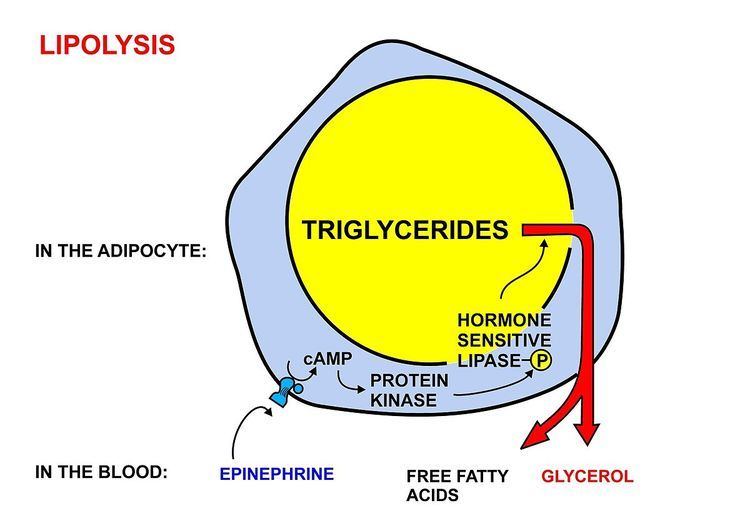 | ||
Lipolysis /lᵻˈpɒlᵻsɪs/ is the breakdown of lipids and involves hydrolysis of triglycerides into glycerol and free fatty acids. The following hormones induce lipolysis: glucagon, epinephrine, norepinephrine, ghrelin, growth hormone, testosterone, and cortisol. These trigger 7TM receptors (G protein-coupled receptors), which activate adenylate cyclase. This results in increased production of cAMP, which activates protein kinase A, which subsequently activates lipases found in adipose tissue.
Triglycerides are transported through the blood to appropriate tissues (adipose, muscle, etc.) by lipoproteins such as Very-Low-Density-Lipoproteins (VLDL). Triglycerides present on the VLDL undergo lipolysis by the cellular lipases of target tissues, which yields glycerol and free fatty acids. Free fatty acids released into the blood are then available for cellular uptake. Free fatty acids not immediately taken up by cells may bind to albumin for transport to surrounding tissues that require energy. Serum albumin is the major carrier of free fatty acids in the blood. The glycerol also enters the bloodstream and is absorbed by the liver or kidney where it is converted to glycerol 3-phosphate by the enzyme glycerol kinase. Hepatic glycerol 3-phosphate is converted mostly into dihydroxyacetonephosphate (DHAP) and then glyceraldehyde 3-phosphate (GA3P) to rejoin the glycolysis and gluconeogenesis pathway.
While lipolysis is triglyceride hydrolysis (the process by which triglycerides are broken down), esterification is the process by which triglycerides are formed. Esterification and lipolysis are, in essence, reversals of one another.
Currently there are four main non-invasive body contouring techniques growing in the aesthetic medicine for reducing localized subcutaneous adipose tissue: low-level laser therapy (LLLT), cryolipolysis, radio frequency (RF) and high-intensity focused ultrasound (HIFU).
Insulin action in the mediobasal hypothalamus has been shown to suppress lipolysis due to lower sympathetic nervous outflow to white adipose tissue. The regulation of this process involves interactions between insulin receptors and gangliosides present in the neuronal cell membrane.
